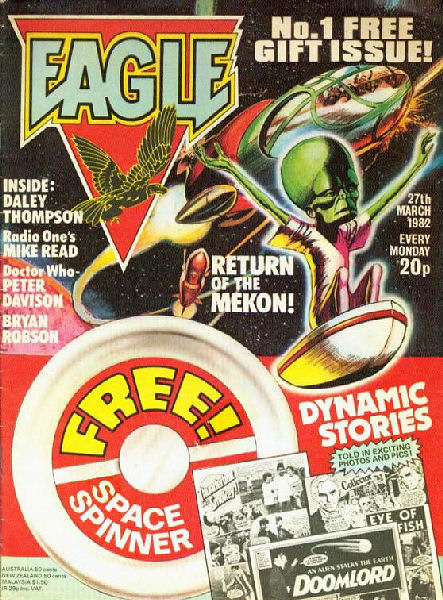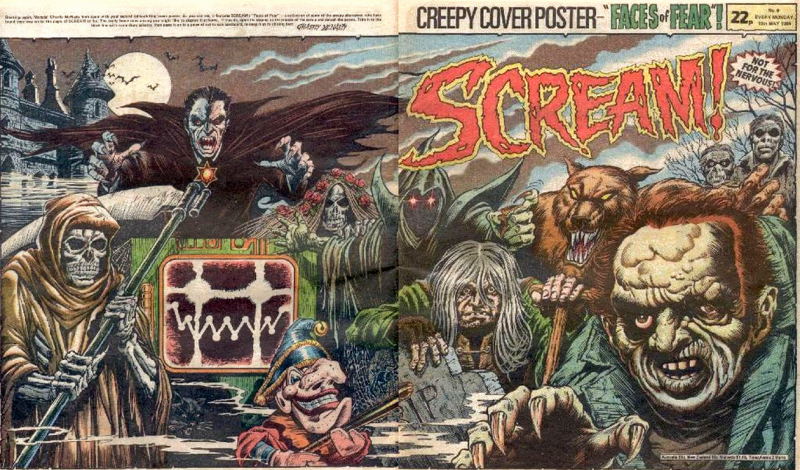Eagle was a seminal British children's
British comics periodical, first published from 1950 to 1969, and then in a relaunched format from 1982 to 1994. It was founded by
Marcus Morris, an
Anglican vicar from
Lancashire. Morris edited a
Southport parish magazine called
The Anvil, but felt that the church was not communicating its message effectively. Simultaneously disillusioned with contemporary children's literature, he and
Anvil artist
Frank Hampson created a dummy comic based on Christian values. Morris solicited the idea to several
Fleet Street publishers, with little success, until
Hulton Press took it on.
Following a huge publicity campaign, the first issue of
Eagle was released in April 1950. Revolutionary in its presentation and content, it was enormously successful; the first issue sold about 900,000 copies. Featured in colour on the front cover was its most recognisable story,
Dan Dare, Pilot of the Future, created by Hampson with meticulous attention to detail. Other popular stories included
Riders of the Range and
P.C. 49.
Eagle also contained news and sport sections, and educational cutaway diagrams of sophisticated machinery. A members club was created, and a range of related merchandise was licensed for sale.
Amidst a takeover of the periodical's publisher and a series of acrimonious disputes, Morris left in 1959; Hampson followed shortly thereafter. Although
Eagle continued in various forms, a perceived lowering of editorial standards preceded plummeting sales, and it was eventually subsumed by its rival,
Lion, in 1969.
Hampson was embittered by his departure from
Eagle.
Although he created Dan Dare, he and Morris had signed contracts which made the space adventurer the copyright of its publisher.
This made it difficult for him to get hold of his original artwork, and excluded him from any profits Hulton made from the huge range of Dan Dare and
Eagle merchandise it licensed.
He called Odhams, the comic's owner after 1960, "
Treens".
Hampson later worked on various advertising commissions, and illustrated seven
Ladybird books. He recovered from cancer to become a graphics technician at Ewell Technical College, and in 1975 at the
Lucca comics convention was declared as the best writer and illustrator of strip cartoons since the end of the Second World War.
At the 1976
Comics 101 British comics convention he was given the
Ally Sloper Award, as the best British strip cartoon artist.
He died at Epsom in July 1985.
His original Dan Dare drawings now command high prices, and have inspired a range of modern artists;
Gerald Scarfe and
David Hockney were first published in
Eagle.
X-Men comic scriptwriter
Chris Claremont read and enjoyed
Eagle, and cites Hampson's work as influential on his career.
Watchmen co-creator
Dave Gibbons has also praised Hampson's work, and the author
Tim Rice, in his foreword to
Living with Eagles (1998), cites the stories printed in
Eagle as helping "me in my story-telling efforts through musicals many years on."
Professor
Stephen Hawking, when asked about the influence Dan Dare had on him, replied: "Why am I in cosmology?", and the entertainer
Kenny Everett chose an
Eagle Annual as his book on
Desert Island Discs.
[74]
The comic industry's
Eagle Awards, first presented in the late 1970s, are named after
Eagle,
[75] and a fan club, the Eagle Society, regularly publishes the quarterly
Eagle Times.
[76]
Eagle was relaunched in 1982 and ran for over 500 issues before being dropped by its publisher in 1994.






